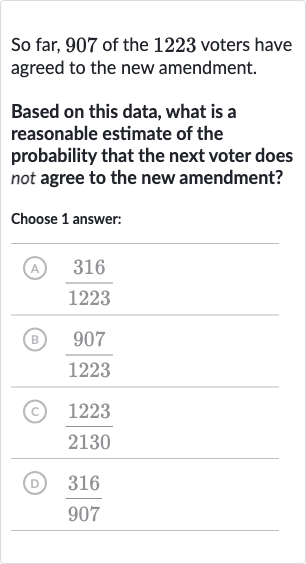AI tutor
Welcome to Bytelearn!
Let’s check out your problem:

So far, of the voters have agreed to the new amendment.Based on this data, what is a reasonable estimate of the probability that the next voter does not agree to the new amendment?Choose answer:(A) (B) (C) (D)
Full solution
Q. So far, of the voters have agreed to the new amendment.Based on this data, what is a reasonable estimate of the probability that the next voter does not agree to the new amendment?Choose answer:(A) (B) (C) (D)
- Determine Voters Not Agreed: Determine the number of voters who have not agreed to the new amendment.To find this, subtract the number of voters who have agreed from the total number of voters. voters in total - voters who agreed = voters who have not agreed.
- Calculate Probability: Calculate the probability that the next voter does not agree to the new amendment.The probability is the number of voters who have not agreed divided by the total number of voters.Probability = (Number of voters who have not agreed) / (Total number of voters)Probability =
- Check Answer Choices: Check the answer choices to see which one matches the calculated probability.(A) matches the calculated probability.(B) is the probability of agreement, not disagreement.(C) is not relevant to the given numbers.(D) is the ratio of disagreeing to agreeing voters, not the probability of the next voter disagreeing.
More problems from Experimental probability
QuestionGet tutor help
QuestionGet tutor help
QuestionGet tutor help
QuestionGet tutor help
QuestionGet tutor help
QuestionGet tutor help
QuestionGet tutor help
QuestionGet tutor help
QuestionGet tutor help
